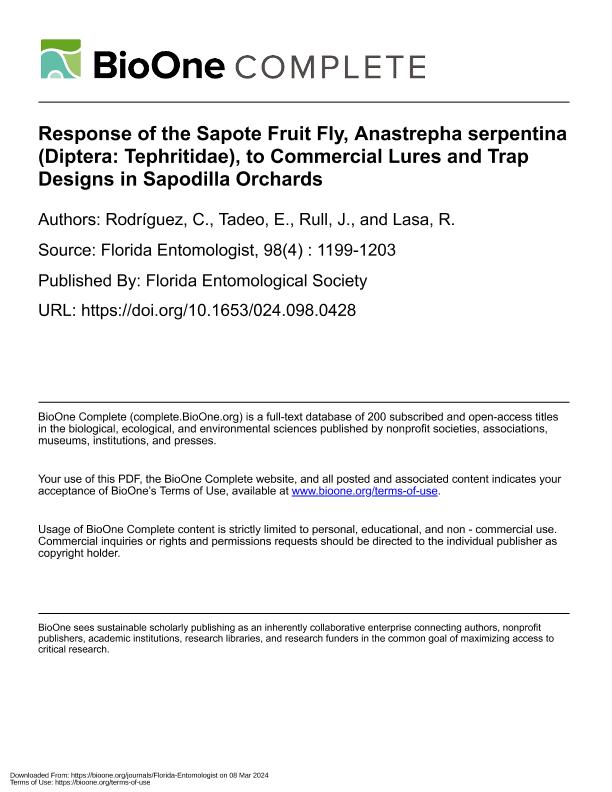Mostrar el registro sencillo del ítem
dc.contributor.author
Rodriguez-Enriquez, Christian Luis
dc.contributor.author
Tadeo, Eduardo
dc.contributor.author
Rull Gabayet, Juan Antonio

dc.contributor.author
Lasa, Rodrigo
dc.date.available
2017-12-13T18:33:15Z
dc.date.issued
2015-12
dc.identifier.citation
Rodriguez-Enriquez, Christian Luis; Tadeo, Eduardo; Rull Gabayet, Juan Antonio; Lasa, Rodrigo; Response of the Sapote Fruit Fly, Anastrepha serpentina (Diptera: Tephritidae) to Commercial Lures and Trap Designs in Sapodilla Orchards; Florida Entomological Society; Florida Entomologist; 98; 4; 12-2015; 1199-1203
dc.identifier.issn
0015-4040
dc.identifier.uri
http://hdl.handle.net/11336/30498
dc.description.abstract
Anastrepha serpentina (Wiedemann) (Diptera: Tephritidae) is one of the least studied of the pestiferous Neotropical tephritid flies despite its propensityto attack several commercial fruit crops, mainly in the Sapotaceae (Ericales). Few studies have been performed to improve monitoring traps and lures specifically targeted at this species. Management currently is achieved by using the hydrolyzed protein lure (Captor® with borax) and a Multilure® trap in combination with chemical control measures. Here, we aimed to evaluate the efficacy of other commercial lures and traps for monitoring purposes in sapodilla orchards. The efficacies of 3 commercial lures, namely, Captor (chemically hydrolyzed protein) + borax, CeraTrap® (enzymatically hydrolyzed protein), and Biolure® (dry lure based on ammonium acetate and putrescine), were compared in 2 independent experiments.In a 1st experiment, CeraTrap caught twice as many A. serpentina flies per trap per day as Captor + borax. In a 2nd experiment, trapping efficacy of CeraTrap and Biolure was similar, and both lures caught more A. serpentina flies per day per trap than Captor + borax. No significant differences in the capture of A. serpentina were observed among a Multilure trap, a Tephi Trap®, or a simple polyethylene bottle trap, when baitedwith CeraTrap. This study contributes with additional information on the response of A. serpentina to commercial lures, showing that CeraTrap couldrepresent an effective alternative to monitor this pest using simple and cheap polyethylene bottle traps.
dc.format
application/pdf
dc.language.iso
eng
dc.publisher
Florida Entomological Society

dc.rights
info:eu-repo/semantics/openAccess
dc.rights.uri
https://creativecommons.org/licenses/by-nc-sa/2.5/ar/
dc.subject
Ceratrap
dc.subject
Biolure
dc.subject
Multilure
dc.subject
Bottle Trap
dc.subject.classification
Otras Ciencias Biológicas

dc.subject.classification
Ciencias Biológicas

dc.subject.classification
CIENCIAS NATURALES Y EXACTAS

dc.title
Response of the Sapote Fruit Fly, Anastrepha serpentina (Diptera: Tephritidae) to Commercial Lures and Trap Designs in Sapodilla Orchards
dc.type
info:eu-repo/semantics/article
dc.type
info:ar-repo/semantics/artículo
dc.type
info:eu-repo/semantics/publishedVersion
dc.date.updated
2017-11-09T20:32:20Z
dc.journal.volume
98
dc.journal.number
4
dc.journal.pagination
1199-1203
dc.journal.pais
Estados Unidos

dc.journal.ciudad
Nueva York
dc.description.fil
Fil: Rodriguez-Enriquez, Christian Luis. Instituto de Ecología; México
dc.description.fil
Fil: Tadeo, Eduardo. Instituto de Ecología; México
dc.description.fil
Fil: Rull Gabayet, Juan Antonio. Consejo Nacional de Investigaciones Científicas y Técnicas. Centro Científico Tecnológico Conicet - Tucuman. Planta Piloto de Procesos Industriales Microbiologicos; Argentina
dc.description.fil
Fil: Lasa, Rodrigo. Instituto de Ecología; México
dc.journal.title
Florida Entomologist

dc.relation.alternativeid
info:eu-repo/semantics/altIdentifier/url/http://journals.fcla.edu/flaent/article/view/84853
dc.relation.alternativeid
info:eu-repo/semantics/altIdentifier/doi/http://dx.doi.org/10.1653/024.098.0428
Archivos asociados
